This canary yellow pottery mug with silver lustre bands and decoration was made in England in the early 19th century. I recently purchased it from a dealer in the UK who used the “tankard” as his pencil cup. He wrote me “(It) sits on my desk. Only dealers appreciate it! My customers think I am crazy”. I, of course, do not think he’s crazy and it’s too bad his customers did not appreciate it, nor see the beauty in the patterns made by the multiple repairs. It did take a little bit of convincing for the dealer to agree to sell it to me and after I told him “please consider how happy the mug will be living in America with other wounded survivors!”, we agreed on a fair price. I sent payment, the mug arrived 2 weeks later and it has become my new favorite piece!
Measures 3-1/2″ tall, 3-5/8″ diameter.
Every angle reveals more and more staples…
Comical poem printed on the front reads:
“The maltster doth crave
His money to have,
The distiller says have it he must;
By this you may see,
How the case stands with me;
So I pray don’t ask me to trust”
After this mug was smashed, the body was held together with the aid of 40 metal staples of varying size and the handle was repaired with 6 metal bands. It must have been truly cherished by whoever had it repaired.
I love the stylized sunbursts, enhanced by the addition of metal staples, on both sides of the mug.
Tags: English, lustre, pottery, staples/rivets
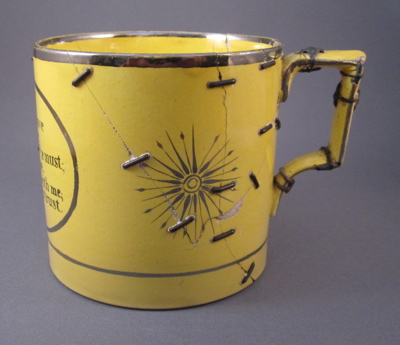
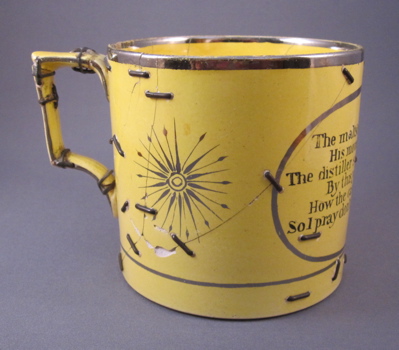
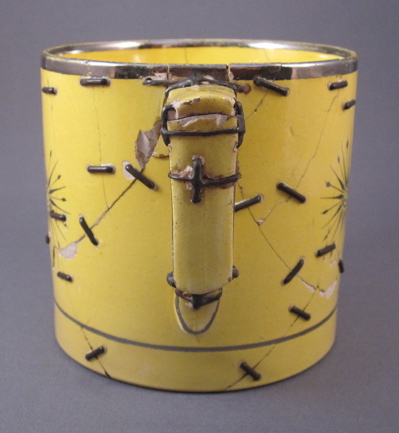

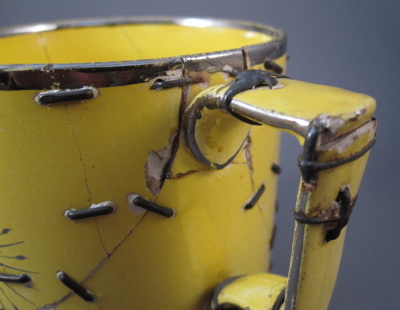
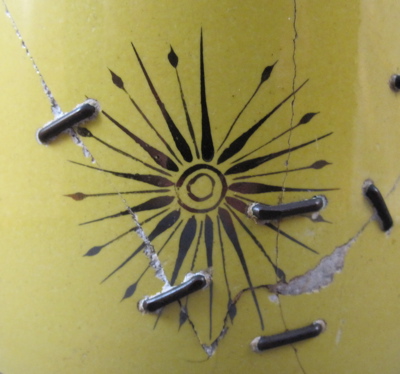
This is my favorite too! So happy it is amongst other “wounded survivors”! Strength in numbers!
Confession….I can’t stop looking at it. I keep returning to this page 🙂
Love this site and check it regularly…
This piece is astonishing!
So much work in the repair…
Must’ve been loved
I love this mug. To think how loved it was that someone put it back together. I have never seen anything like this. How in the world do you staple a mug back together?
I am pleased that the tankard has found a true home.
Yes…I was reluctant to sell it as it was so full of heart.
It is gratifying to see comments from other admirers and the sharing of this piece with you is very warming to me.
I will print your page and keep the copy as a reminder of my favorite “make do”.
I am back again to gaze at this amazing tankard! Look at the handle….I love the way it was put back together. Thank you John Howard for sending your “favorite make-do” to America and thank you Andrew for putting it up on your blog. Thank you! Thank you!
wow. 40 staples.
I have seen staples before but this a fantastic multiple example! Outstanding sample of the past workmanship!
What a beauty…and to think of how much someone really cared about this tankard to take the time to staple it back together. a labor of love.thank you for finding, purchasing and sharing.
very strange… how would it be possible to staple it back together successfully? ever try doing that? is it really glued and the staples decorative? Most curious
It is wonderful ! I have been wondering just how one goes about stapling a piece? Drill small holes first? Tap the staple in with a hammer gently? Is/was there a “stapler” made for such repairs? Thanks
Bravo! Love this one! I want a new handheld machine that can stable china pieces together — wouldn’t that be something?
I knew this amazing piece would stir up some great comments! Thanks for sending. For those of you unfamiliar with staple repair on porcelain, pottery and glass, please take a look at an earlier post which briefly explains the process: “How did they do that?” (http://andrewbaseman.com/blog/?p=1818).
This is a beautiful piece . I think the word in the first line of the poem is “maltsier” a maker of or dealer in malt. Possibly the tankard was made for a publican and the poem an explanation of a “No credit” policy?
Hi Andrew,
Love this Canary Yellow item. My father has a miniature Canary Yellow mug with the name William in silver lustre. No staples only a chip.
40 staples is good but my record piece has 48 staples. It is an 18th century urn shape soup tureen decorated with Deutsche Blumen decoration. Its design imitating a silver tureen. It has some serious damage but someone has lovingly put it back together again, 48 staples and two metal straps later. A bit like Humpty Dumpty..
What a delightful mug. I hope you don’t mind Andrew, but I feel compelled to write to clarify the verse. The second word is actually MALTSTER not master. A Maltster is someone who malts barley. As you probably know, malt is a thick sweet honey-like substance extracted from barley used in brewing beer. If the landlord made his own beer on-site, he’d have to have bought his malt from the maltster. Distillers supplied the spirits like whisky and gin etc. Basically, the verse bemoans the suppliers that the poor innkeeper or proprietor had to pay. The maltster and the distiller both demand cash on delivery, and that’s why he cannot extend credit to his drinking patrons ie ..”don’t ask me to trust” (..that you’ll pay me later for your drinks) :-/ Another version substitutes the word Exciseman (customs import tax collector) for Distiller. Not much has changed in a few hundred years. Keep up the good work bringing these survivors to a wider audience. All the best.